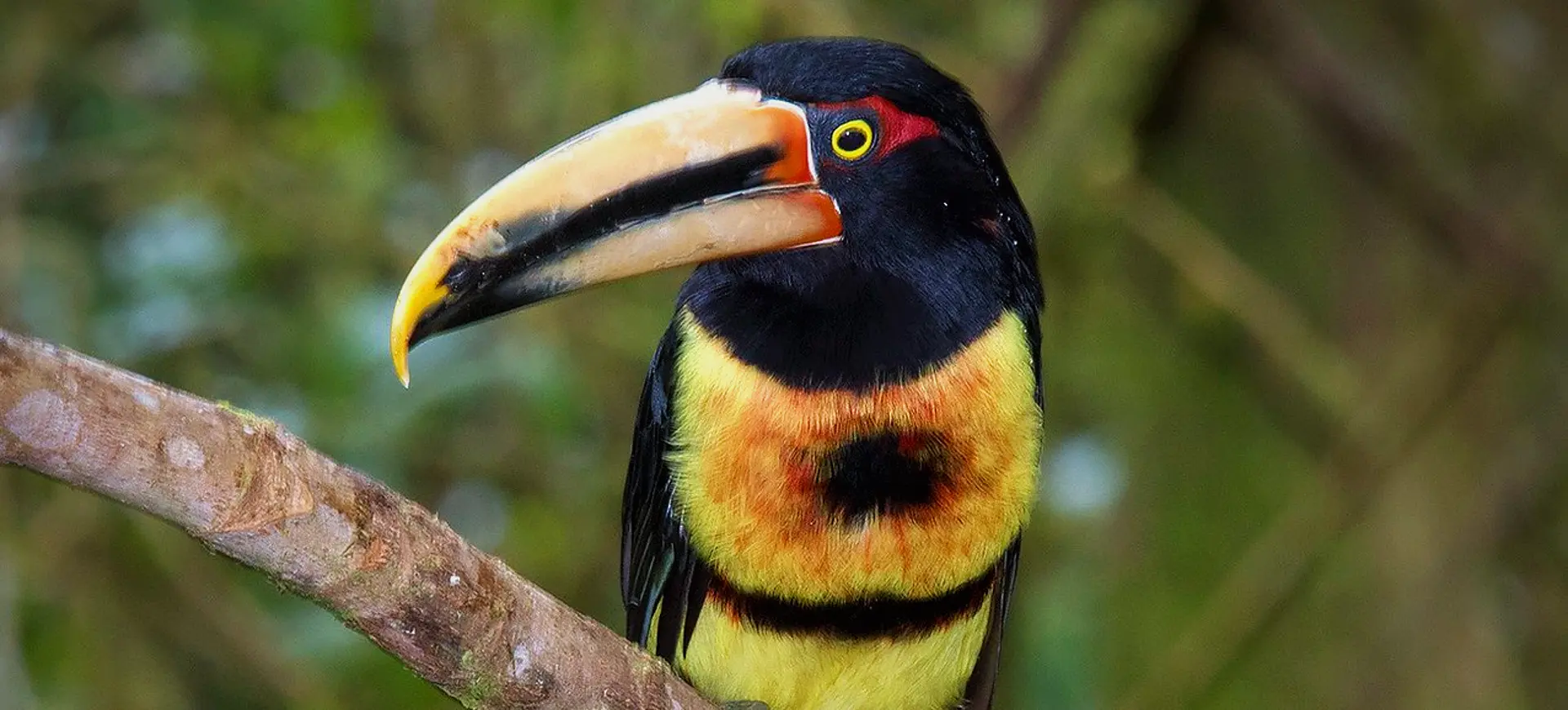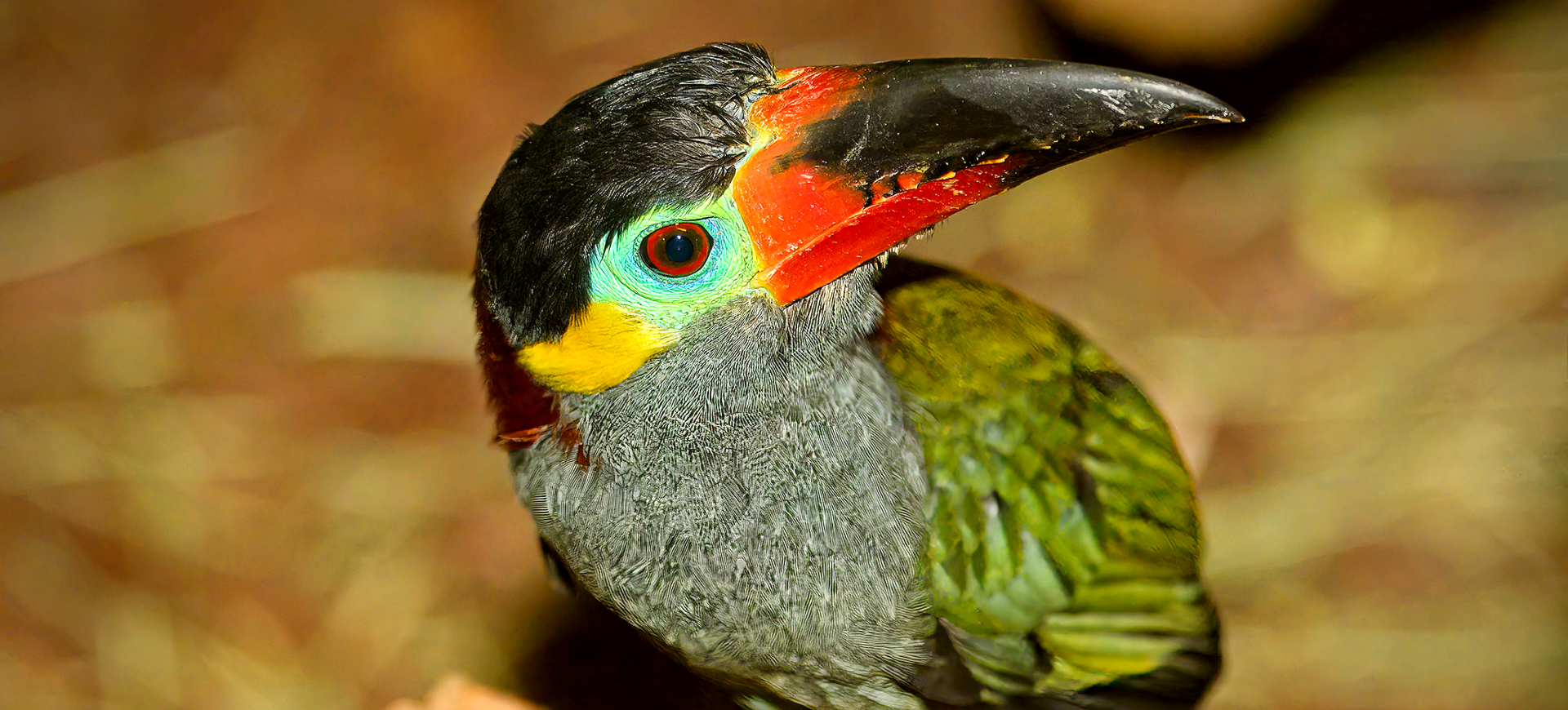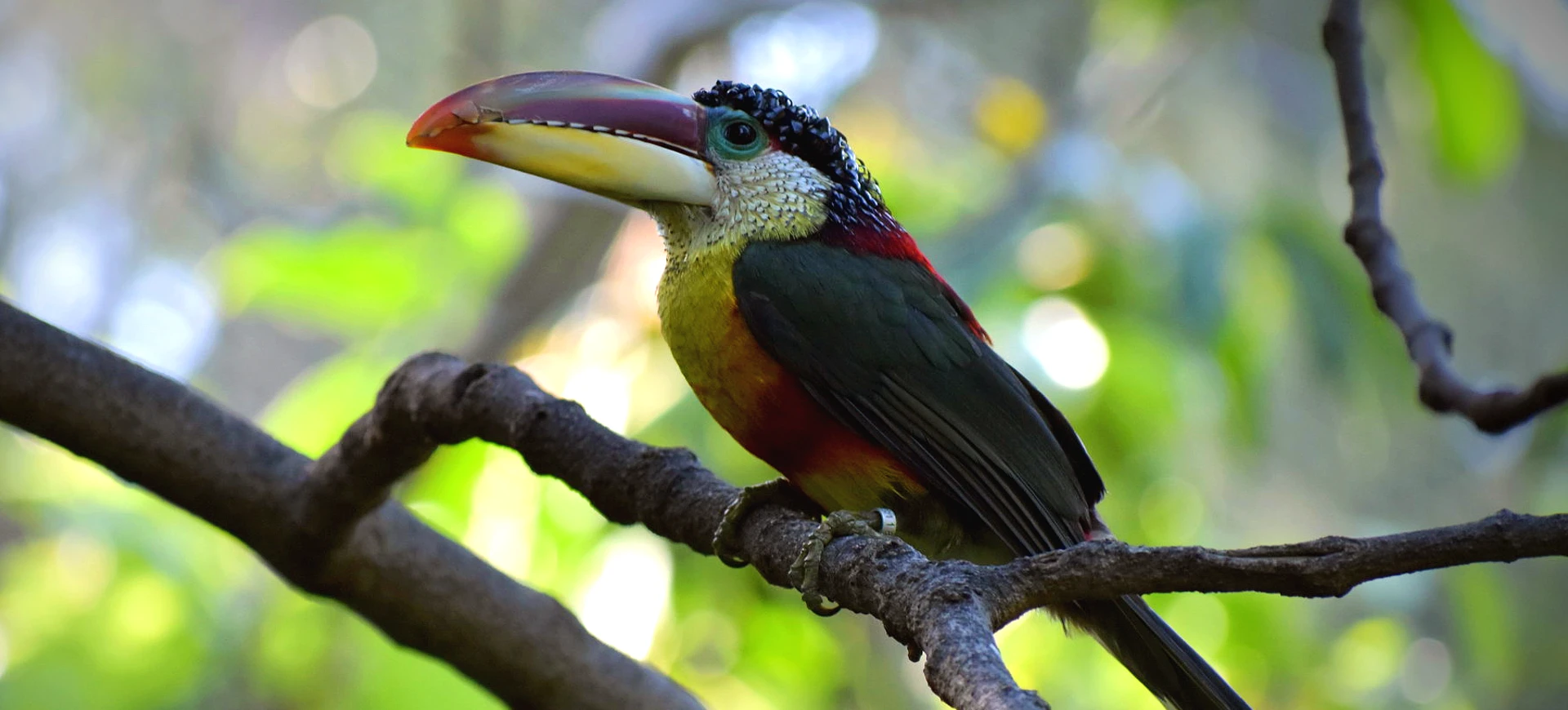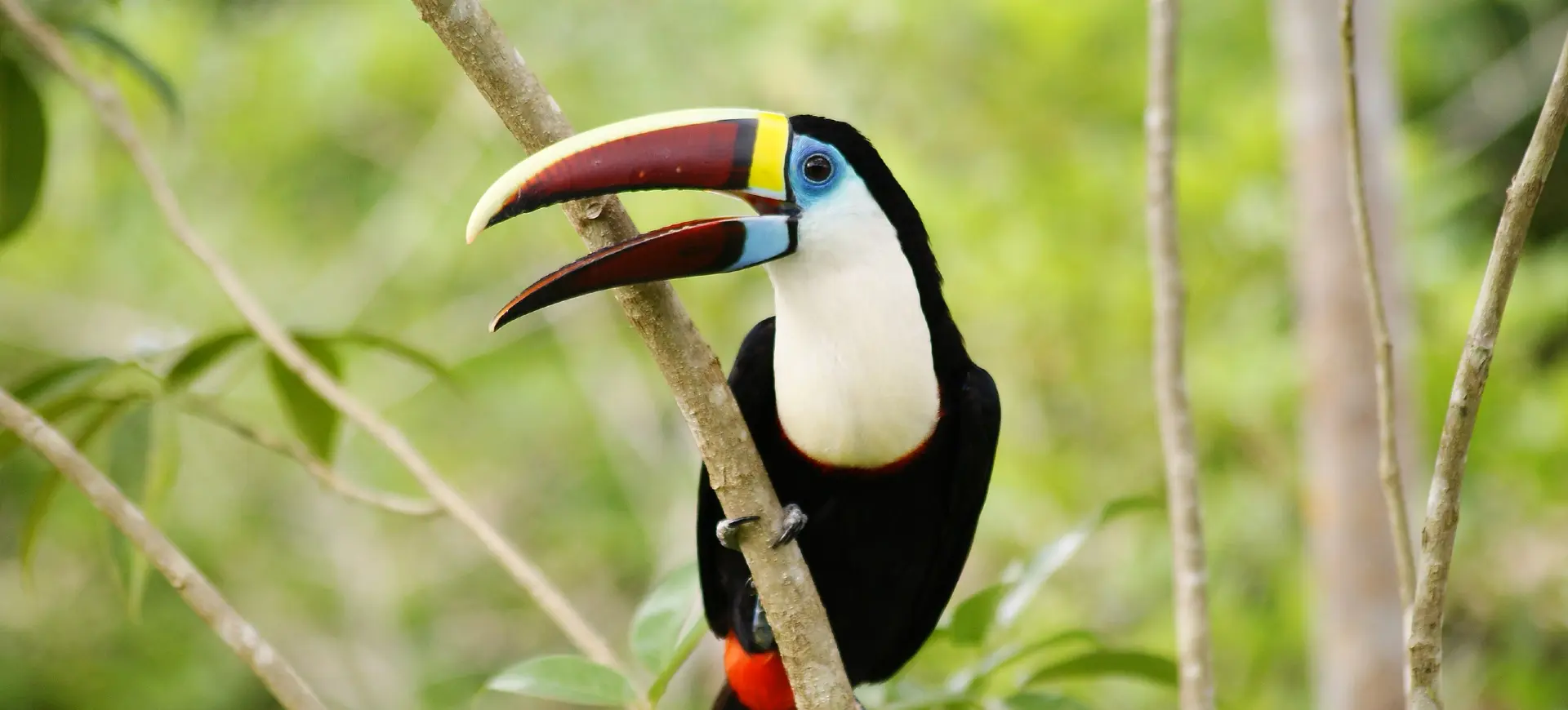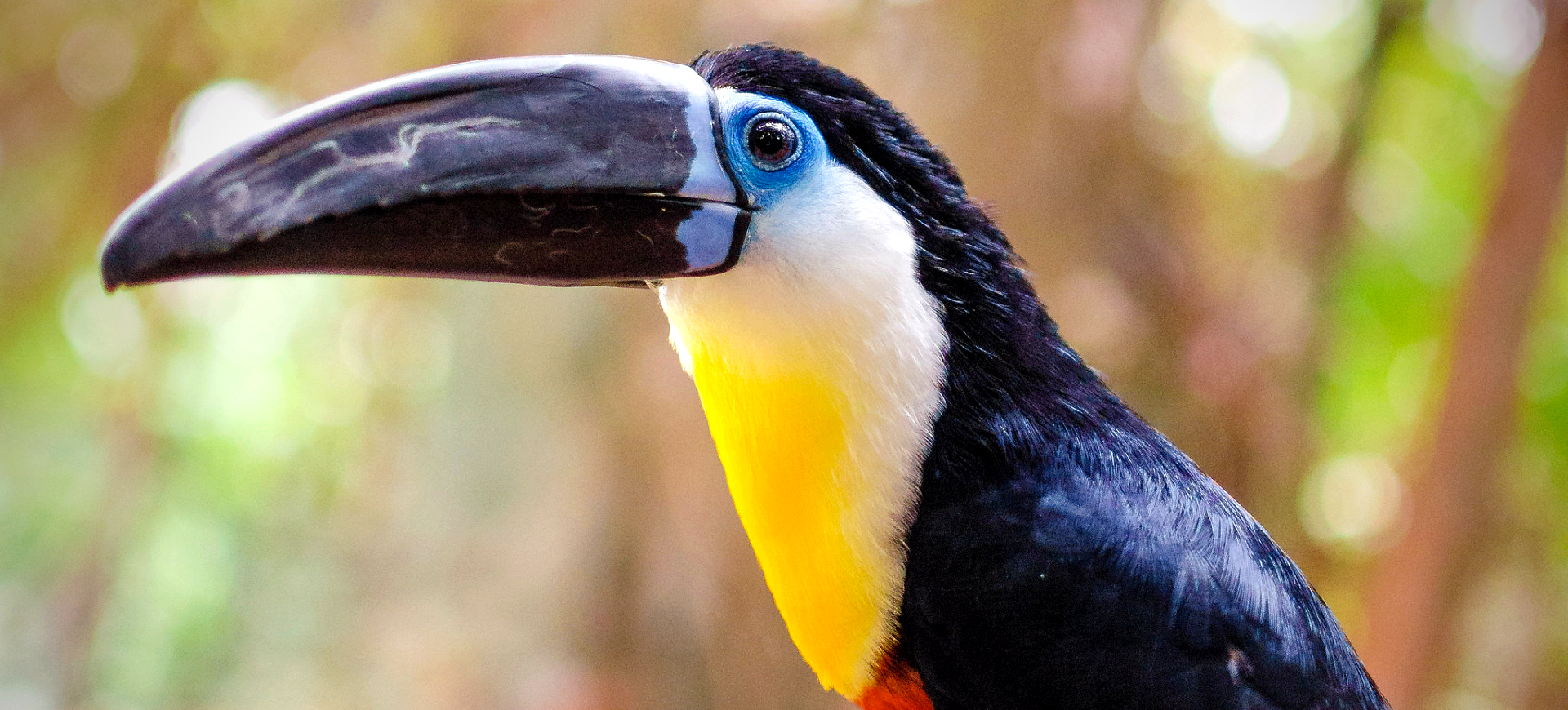Overview
The Toco Toucan is a large, colorful bird native to South America, most recognizable for its oversized, orange bill and striking black plumage with a white throat. The bill, although large, is surprisingly light due to its porous structure and serves various functions, including feeding, preening, and thermoregulation. The Toco Toucan is the largest species in the toucan family and is often considered the most iconic.
Primarily frugivorous, the Toco Toucan plays a crucial role as a seed disperser in its ecosystem. It consumes various fruits and occasionally supplements its diet with insects, small vertebrates, and bird eggs. The bird is known for its loud, frog-like croaks, which communicate among individuals and groups.
The Toco Toucan is popular in indigenous art and modern media, symbolizing exotic beauty and freedom. However, despite its popularity, the species faces threats from habitat loss and the pet trade. It is currently listed as “Least Concern” by the IUCN, but ongoing conservation efforts are essential to monitor and protect this charismatic species.
Taxonomy
Kingdom
Phylum
Class
Order
Family
Genus
Species
Sub Species
Type
Physical Description:
The Toco Toucan is most notable for its large, orange bill, measuring up to 8 inches long. Despite its size, the bill is incredibly light, thanks to a structure of bone struts filled with keratin. The bird’s plumage is predominantly black, with a white throat and chest and blue skin around its eyes.
Adult Toco Toucans typically weigh between 1.5 to 1.7 pounds. They have a body length ranging from 22 to 26 inches, and their wingspan can reach up to 44 inches. Both males and females are similar in appearance, although males are generally slightly larger than females.

Lifespan: Wild: ~20 years || Captivity: ~25 years

Weight: Male: 1.6–1.7 lbs (725–770 g) || Female: 1.5–1.6 lbs (680–725 g)

Length: Male: 24–26 inches (61–66 cm) || Female: 22–24 inches (56–61 cm)

Wingspan: 42–44 inches (107–112 cm)

Top Speed: 25 mph (40 km/h)
Characteristic:
Native Habitat:
The Toco Toucan is native to South America’s tropical and subtropical forests. It is commonly found in lowland rainforests but can adapt to more open habitats like savannas and plantations. The species prefers areas with high trees, providing food and nesting sites.
The bird is highly territorial and usually lives in small groups. It is most active during the day, spending most of its time foraging for food and interacting with other members of its group. The Toco Toucan is a non-migratory species, generally staying within a defined home range throughout its life.
Climate Zones:
Biomes:
Biogeographical Realms:
Continents:
Diet:
Diet & Feeding Habits:
The Toco Toucan primarily feeds on various fruits, making it an essential seed disperser in its ecosystem. It uses its large bill to pick fruits from branches too small to support its weight. The bird also uses its bill to skin the fruit before consuming it, and it has a specialized tongue that aids in this process.
While fruits comprise most of its diet, the Toco Toucan is an opportunistic feeder. It will also consume insects, small vertebrates, and bird eggs when available. This varied diet allows the Toco Toucan to adapt to different environments and food availabilities, contributing to its relatively wide distribution.
Mating Behavior:
Mating Description:
The Toco Toucan’s mating season occurs during the spring and early summer. During this period, males perform various displays to attract females, including bill-fencing and vocalizations. Once a pair is formed, they engage in mutual preening and feeding, strengthening their bond.
The female lays 2 to 4 eggs in a tree cavity, which both parents take turns incubating. After about 16 to 20 days, the eggs hatch, and the chicks are born blind and featherless. Both parents feed and care for the young, who fledge after about 6 to 8 weeks. The young birds remain with their parents for several weeks after fledging, learning essential skills for survival.
Reproduction Season:
Birth Type:
Pregnancy Duration:
Female Name:
Male Name:
Baby Name:
Social Structure Description:
The Toco Toucan is a social bird that typically lives in small groups of up to six individuals. These groups are often composed of family members and are highly territorial. The birds communicate through various vocalizations, including croaks and whistles, which coordinate group activities and establish social hierarchies.
The social structure becomes more complex during the breeding season as pairs form and engage in nesting activities. After the young fledge, they usually remain with their parents for several weeks, forming larger family groups. The Toco Toucan is not migratory and tends to stay within a defined home range, although some local movements may occur in response to food availability.
Groups:
Conservation Status:
Population Trend:
The Toco Toucan is currently listed as “Least Concern” by the IUCN, indicating that it is not immediately threatened with extinction. The species is relatively abundant in many parts of its range, particularly protected areas and reserves. However, it faces habitat loss and fragmentation threats, primarily due to deforestation and agricultural expansion.
Despite these challenges, the Toco Toucan has shown a remarkable ability to adapt to changing environments. It is a common sight in many parts of South America, in natural habitats and areas modified by human activity. Ongoing monitoring and conservation efforts are essential to ensure the long-term survival of this iconic species.
Population Threats:
The primary threats to the Toco Toucan population are habitat loss and fragmentation, mainly due to deforestation for agriculture and logging. The species is also targeted by the illegal pet trade, which can have a significant impact on local populations. Additionally, the bird faces risks from hunting, both for sport and traditional medicine.
Climate change poses another potential threat, as temperature and precipitation pattern shifts could impact food availability and suitable nesting sites. However, the Toco Toucan’s adaptability and broad range provide some buffer against these threats, making it less vulnerable than more specialized species.
Conservation Efforts:
Conservation efforts for the Toco Toucan primarily focus on habitat preservation and establishing protected areas. Several reserves and national parks within its range provide safe habitats where the species can thrive. Additionally, stricter law enforcement and public awareness campaigns are being made to combat illegal trade and hunting.
Education and community engagement are also crucial components of conservation strategies. Local communities are being educated about the ecological importance of the Toco Toucan and the need for its protection. Research is ongoing to better understand the species’ ecology and behavior, which will inform future conservation efforts.
Additional Resources:
Fun Facts
- The Toco Toucan’s bill can be up to one-third of its body length.
- Despite its size, the bill is incredibly light due to its porous structure.
- The species is an important seed disperser in its ecosystem.
- Toco Toucans are known for their loud, frog-like croaks.
- They are monogamous during the breeding season.
- The bird is highly adaptable and can live in a variety of habitats.
- Toco Toucans are popular in both indigenous art and modern media.
- They are non-migratory and usually stay within a defined home range.
- The species is relatively abundant but faces threats from habitat loss and the pet trade.
- Toco Toucans have a lifespan of up to 25 years in captivity.





